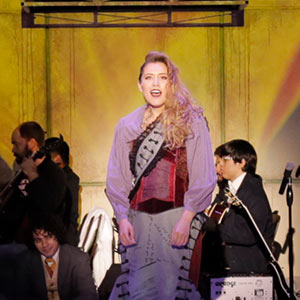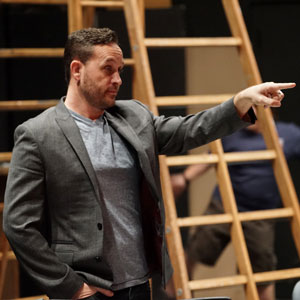'Prisoner' Reflects Mood
— Fullerton College Hornet - Paula Selleck - Friday, May 9th, 1975Musing over the splendid paradoxes of Neil Simon's wit, FC dramatists staged an auspicious opening weekend of "The Prisoner of Second Avenue." The Campus Theatre housed the production which will continue through May 10.
Engulfed in New York's steaming and teeming metropolis, Simon's protagonists, a middle-aged married couple, struggle to escape the smothering confines of their Second Avenue apartment in this playwright's version of modern misery.
Eric Hanson and Pam Lind play Mel and Edna Edison, who are first robbed of all valuable possessions and then left without income when Mel loses his job because of the country-wide economic set back.
Acting
Hanson's well rehearsed performance allowed him to concentrate fully on characterization. The dissatisfied, vocal and confident Mel slowly becomes withdrawn, easily upset and listless. Hanson convincingly effected these changes utilizing body language and distinctive voice inflections.
The highpoints of his performance include encounters with unseen neighbors on the terrace and his desolation at becoming the "housewife" while his wife works to support them.
Pam Lind was somewhat encumbered due to the static role of Edna Edison. She is a distressed woman throughout the play and there is no true relief from this position except when she comforts her husband. The consequent difficulty of showing degrees of displeasure is not realized by Lind and her performance suffers from an early climax. The peak is reached too soon to sustain for the duration of the comedy, and Lind shows signs of strain in the second act.
The quality of her performance improved with the course of the play. She was at her best while taking a stand with Mel's meddling relatives. Here, she pleads, commands and stamps with conviction.
Visiting Relatives
In the brief scene involving the three elderly sisters of Mel and his nervous brother, the discussion revolved around Mel's supposed breakdown. The old biddies looked down noses, strutted about in pointed higheels, sipped coffee and gave useless advice in such a way that brought knowing murmers from the older members of the audience.
This humorous interlude featured Rebecca Godinez as Jessie, who cried well; Colleen Malone as the taciturn Pauline, Kevin Coots as the baggypants Harry and Sue DiMascio as Pearl, the most eccentric relative. DiMascio was also the most delightful to watch because of her constant gesturing and rich portrayal of a distasteful relation.
Well Directed
There were a few rough spots in the blocking that stopped the action only momentarily. For the most part, an absorbed audience watched players who moved about .with seeming purpose. One of the best directed scenes involving precise timing and spontaneous reaction came in the first act when Mel returned home from work to find his apartment ransacked and his wife wailing. Their discoveries of what was missing constituted one of the more humorous segments of the play.
Faculty Director George L. Stoughton and Assistant Director Jon Bouvia employed various use of props and set design to give life to a play written more for listening than viewing.
Imaginative Set
The set, designed by Todd Glen, was an impressive creation that included such detail as shelving, bricked and paneled walls, painted backdrops, ceiling and wall fixtures and functional doors. A partial view of the kitchen and bedroom gave added dimension to the living room which comprised the main stage area.
Sandwiched between scenes of each act were news accounts of the nation's events that illustrated the absurdity and turmoil of American life. These were announced from off stage while an enlarged eye appeared before a closed curtain to signify television's presence.
The costumes, chosen by Debra Durant and Debra Garrison seemed appropriate to the personalities of the characters as well as to the fashion trends of today.
The performance commenced at 8 p.m








